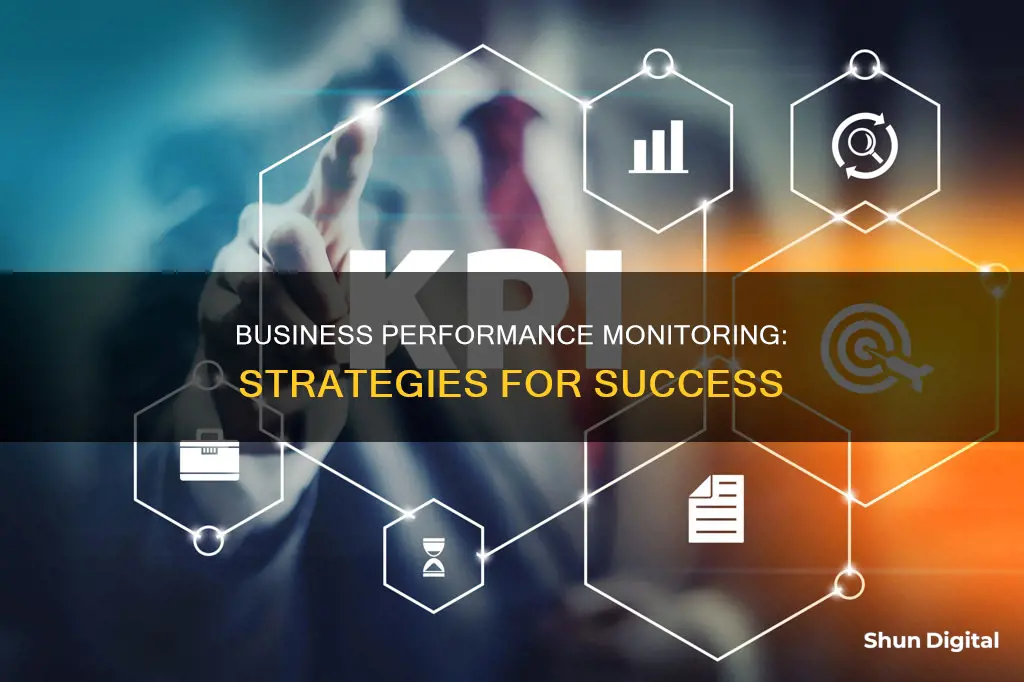
Performance monitoring is an essential component of a business's success. It involves tracking and analyzing key performance indicators (KPIs) to evaluate a company's overall health and effectiveness. By measuring metrics such as revenue, customer satisfaction, and operational efficiency, businesses can gain valuable insights to improve decision-making, boost efficiency, and drive growth. Performance monitoring can be applied to various areas, including financial, operational, customer, and employee performance. It is a perpetual cycle of improvement, providing a strategic advantage and enabling businesses to adapt to changing market dynamics.
| Characteristics | Values |
|---|---|
| Purpose | To evaluate the overall health and effectiveness of a business |
| Scope | Financial, operational, customer-centric, employee-centric |
| Benefits | Improved decision-making, boosted efficiency, enhanced growth, increased profitability, improved operational efficiency, increased employee retention, improved accountability |
| Data Collection | Automated systems, standardized processes, quality checks |
| Tools | Analytics platforms, dedicated performance management software, cloud-based solutions, AI and machine learning, dashboards, strategy maps |
| Process | Define objectives, identify KPIs, select tools, collect data, establish baseline metrics, set goals, track progress, establish reporting mechanisms |
| Communication | Transparent sharing of insights, recognition of successes, open dialogues, clear communication of objectives and expectations |
| Employee Performance Measurement | Quality of work, speed and efficiency, trust and consistency, productivity tracking, feedback |
What You'll Learn

Financial performance monitoring
Key Financial Statements
The preparation of essential financial statements, such as the balance sheet and profit/loss statement, is fundamental. These statements offer a snapshot of the company's financial health, detailing assets, liabilities, equity, revenue, expenses, and profits. They are required by law and provide a basis for understanding the business's performance.
Tracking Revenue, Profit Margins and Cash Flow
Analysing Overheads and Marketing Expenses
Overhead expenses, such as rent, salaries, and marketing costs, can significantly impact a company's profitability. Analysing these expenses helps assess whether they are controlled or hindering financial performance. Similarly, evaluating marketing expenses and their returns helps determine the financial efficiency of marketing initiatives.
Inventory Records and Asset Management
Maintaining accurate inventory records is essential for businesses dealing with machinery, equipment, and raw materials. It enables companies to track stock purchases, usage, waste, and equipment maintenance. Additionally, monitoring total asset turnover helps assess how effectively the company uses its assets to generate revenue.
Working Capital and Financial Ratios
Preparing working capital statements and calculating financial ratios, such as current ratios and quick ratios, provides insights into the company's liquidity and ability to meet short-term obligations. These calculations help stakeholders understand the company's financial position and make informed decisions regarding funding and operations.
Competitive Analysis and Benchmarking
Comparing financial indicators with those of competitors is essential for context and improvement. It helps businesses identify areas where they can control costs or increase revenues by learning from industry peers. Benchmarking also allows companies to assess their market position and make strategic adjustments.
By implementing these financial performance monitoring techniques, businesses can gain valuable insights into their financial health, identify areas for improvement, and make data-driven decisions to drive growth and long-term success.
Monitor Internet Usage: Bloom Broadband's Comprehensive Solution
You may want to see also

Operational performance monitoring
Define Clear Objectives:
Begin by outlining specific goals for your business, including areas like sales performance, customer satisfaction, and operational efficiency. This initial step provides a foundation for subsequent monitoring and improvement efforts.
Identify Key Performance Indicators (KPIs):
KPIs are measurable metrics that align with your defined objectives. Examples include revenue, profit margins, customer retention rates, and operational efficiency metrics. These indicators provide data-driven insights to track progress and success.
Select Appropriate Tools:
Choose performance monitoring tools that suit your business's unique needs. This could include analytics platforms or dedicated performance management software. Consider scalability, user-friendliness, and integration capabilities to ensure seamless implementation.
Collect Data on KPIs:
Establish robust processes for collecting relevant data related to your chosen KPIs. This may involve integrating data sources, setting up tracking mechanisms, and ensuring data accuracy. The effectiveness of your operational performance monitoring heavily relies on the quality and consistency of the data collected.
Establish Baseline Metrics and Set Goals:
Before initiating active monitoring, establish baseline metrics for each KPI to provide a reference point. This allows you to gauge improvement, identify concerns, and set achievable targets. By defining acceptable thresholds, you can quickly identify deviations from desired performance levels.
Track Progress and Establish Reporting Mechanisms:
Integrate real-time monitoring to keep a pulse on your operational performance. Develop comprehensive reporting structures that translate raw data into meaningful insights. Utilise dashboards and visualisations to highlight key trends, performance against targets, and areas requiring improvement.
Adapt to Feedback and Make Timely Adjustments:
Regularly review and analyse the data to identify potential issues or opportunities for improvement. This proactive approach enables you to make timely adjustments and optimise your operational processes.
By implementing these steps, businesses can improve decision-making, boost efficiency, and drive growth through effective operational performance monitoring.
Adjusting Your ASUS Monitor: Raising It to New Heights
You may want to see also

Customer performance monitoring
Reviewing Written Correspondence
Analysing written communication with customers, including letters, emails, and live chat records, can provide insights into how well customer service representatives are meeting their needs. This helps identify any issues or areas for improvement in the customer service provided.
Monitoring Phone Calls
Recording phone conversations with customers and having representatives review their own calls can be an effective way to improve their performance. These recordings can also be used for training purposes, ensuring that representatives are offering the best possible support.
Asking Customers for Feedback
Gauging customer feedback is a valuable way to understand their satisfaction and identify problem areas. Customers can provide objective feedback as they are directly involved in the process, and improvements will benefit them. Surveys and questionnaires, and offering incentives such as discounts or prize draws can encourage participation.
Using Mystery Shoppers
Mystery shopping is a technique where professionals are hired to anonymously evaluate the quality of customer service and overall experience. They complete transactions and provide specific, measurable feedback. This method ensures an unbiased assessment, as employees are unaware of the shopper's identity, but it only provides a snapshot of a single moment in time.
Analysing Financial Data
Examining financial metrics such as sales, customer visits, complaints, inquiries, and cross-sales can reflect the overall performance of the company. This data can be used to motivate and train employees, providing them with a comprehensive understanding of the company's performance.
Social Media Monitoring
With the rise of social media, businesses must also monitor online platforms to understand how customers perceive their brand. Social listening tools help track customer conversations and identify areas where improvements can be made to enhance the customer experience.
Hooking Up an External Monitor to Your 2009 iMac
You may want to see also

Employee performance monitoring
Defining Employee Performance Monitoring
Key Metrics for Employee Performance Monitoring
The specific metrics used to measure employee performance may vary depending on the type of business and its unique objectives. However, some standard metrics include:
- Quality of Work: This is a fundamental indicator of employee performance. It assesses whether employees are ensuring high-quality results and meeting performance objectives.
- Speed and Efficiency: Monitoring the quantity of work completed by employees encourages them to be more efficient. Regularly checking whether they are completing tasks within the given timeframe and identifying any obstacles can improve overall productivity.
- Trust and Consistency: Trust and consistency are essential for the success of any company. Evaluating whether employees can work independently, represent company values, and consistently produce strong results without constant supervision is crucial.
Benefits of Employee Performance Monitoring
- Improved Workforce Management: Monitoring employee performance helps in effective workforce and resource management. By keeping current and future workloads transparent, businesses can analyse future employee requirements and make necessary adjustments.
- Increased Employee Retention: Regular employee feedback has been linked to lower turnover rates. Performance monitoring ensures that expectations and objectives are clear and regularly reviewed, contributing to higher employee retention.
- Enhanced Accountability: Performance monitoring fosters a culture of accountability by defining the company's mission, values, and goals. When employees understand their role in achieving these standards, they are more likely to take responsibility for their work.
- Identifying Employees for Promotion: A transparent performance review process helps identify employees who are suitable for promotion. It ensures that promotions are based on merit and provides a clear perspective on employees' capabilities.
Best Practices for Employee Performance Monitoring
To effectively implement employee performance monitoring, consider the following steps:
- Communicate Clear Expectations: Employees should understand the expected timeframe for task completion. This sense of urgency can boost their workflow. Additionally, encourage employees to set their own goals with timelines to increase their sense of ownership.
- Measure Both Short-Term and Long-Term Performance: Effective performance measurements should consider both short-term task completion and long-term achievements. This approach provides a more comprehensive understanding of the impact of employees' work.
- Individualize the Approach: Different employees require different management approaches. Understanding their preferences and behaviour can help tailor your communication and supervision style to bring out their best performance.
- Match Tasks to Skills: Assigning tasks according to employees' skill sets can streamline the work process and improve overall efficiency. It ensures that tasks are allocated to the most suitable individuals.
- Utilize Employee Performance Monitoring Tools: Various software tools, such as EmpMonitor, offer centralised dashboards to track and optimise employee performance. These tools provide valuable insights into employees' activities, productivity, and efficiency.
In conclusion, employee performance monitoring is a vital aspect of business success. By tracking and evaluating employee performance, businesses can make data-driven decisions, improve productivity, and create a culture of continuous improvement.
Energy-Efficient Monitors: CRT vs LCD Displays
You may want to see also

Quality performance monitoring
Financial performance monitoring focuses on metrics such as revenue, profit margins, and cash flow, providing insights into the company's fiscal health. Operational performance monitoring ensures streamlined workflows and resource optimisation by assessing the efficiency of internal processes. Customer performance monitoring measures customer satisfaction and loyalty by examining feedback, retention rates, and Net Promoter Scores (NPS). Employee performance monitoring evaluates workforce productivity, engagement, and skill development.
To set up effective quality performance monitoring, businesses should follow these steps:
- Define objectives: Clearly outline the specific goals and objectives of your business, identifying key areas for improvement such as sales performance, customer satisfaction, or operational efficiency.
- Identify KPIs: Pinpoint the KPIs that align with each goal to track measurable data and evaluate progress.
- Select appropriate tools: Choose performance monitoring tools that suit your business needs, such as analytics platforms or dedicated performance management software.
- Collect data: Establish robust processes for collecting relevant data related to your KPIs, ensuring data accuracy and consistency.
- Establish baseline metrics: Set baseline metrics for each KPI to gauge improvement or identify concerns, providing context for future analysis and decision-making.
- Set goals for KPIs: Define acceptable thresholds and achievable targets for each KPI to quickly identify deviations and prompt timely interventions.
- Track progress: Integrate real-time monitoring to keep a pulse on your business's performance and make informed decisions.
- Establish reporting mechanisms: Develop a comprehensive reporting structure that translates raw data into meaningful insights for stakeholders.
Additionally, businesses should consider the following tips for quality monitoring:
- Choose the right evaluators: Invest in dedicated individuals or teams to monitor quality, ensuring a well-thought-out strategy.
- Encourage self-evaluation: Agents can score their calls and compare with others to promote self-awareness and a shared understanding of good and bad service.
- Focus on under-performers: Increase the sample size for agents below a certain score to identify problem areas and provide targeted training.
- Targeted call selection: Use simple technologies to find calls requiring attention, rather than random selection, to gain accurate insights into agent performance.
- Collaborative evaluation: Involve agents, team leaders, and customer service managers in evaluating the same call to encourage discussion and improve feedback buy-in.
- Feedback structure: Use a 'stop, start, and continue' structure for feedback sessions, allowing agents to set their own goals and take ownership of improvements.
- Customer-centric scoring: Focus on what is important to the customer rather than internal expectations to enhance the customer experience.
- Multi-skilled feedback: In multi-skilled contact centres, monitor specific coaching opportunities related to sales, retention, and cancellations.
ViewSonic VA1938wa-LED: Does it Have HDMI?
You may want to see also
Frequently asked questions
Performance monitoring in business involves tracking and analysing key performance indicators (KPIs) to evaluate the overall health and effectiveness of a company.
Examples of KPIs include revenue, profit margins, cash flow, customer satisfaction, employee productivity, and operational efficiency.
Performance monitoring can improve decision-making, boost efficiency, and drive growth. It can also help identify issues and solutions, increase operational visibility, and ensure transparency.
Performance monitoring provides real-time visibility into key metrics, enabling businesses to identify potential issues and opportunities for improvement. It enhances the decision-making process by providing financial, operational, and customer-centric data.
Performance monitoring can be conducted at different intervals depending on the needs of the business. Reports can be generated daily, weekly, monthly, or annually to provide updates on the business's performance.







